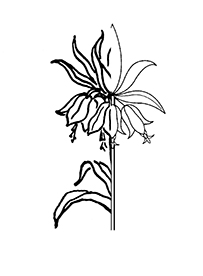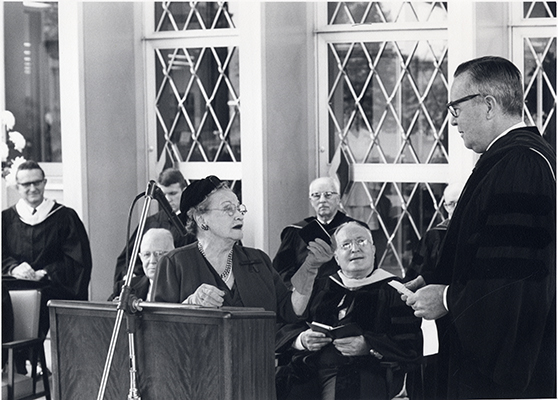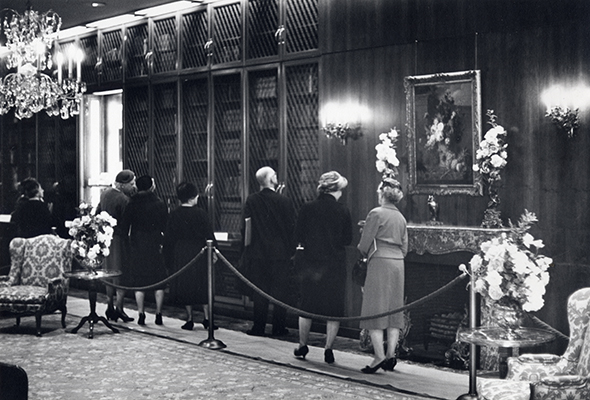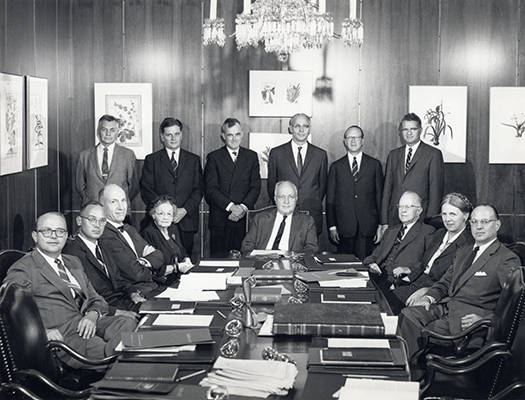Hunt Botanical Library
Although several institutions were vying to acquire her collection, Rachel and Roy hoped to keep it in Pittsburgh. After some consideration they offered it to Carnegie Institute of Technology, along with a new building, followed by a formal commitment in October 1958. The Hunts worked with Lawrie & Green and Schell, Deeter & Knabe to design a building that would be both modern and traditional, the aluminum and glass reflecting Roy's business and the Hunt Botanical Library facility's interior reflecting Rachel's aesthetics and the feel of her home library. As Rachel wrote in a 4 November 1959 letter, "I am to have the Penthouse atop the Library building for my botanical books, prints and original drawings, botanists portraits, etc. and while I shall be heartbroken to part with the books from my own library here, I am happy to know that they will be so well taken care of for many years to come" (Hunt 1959). Construction commenced in November 1959 and ran through October 1961 with the building costing $2.8 million.
As building construction began, Rachel focused on choosing an appropriate décor for the floor that would house her beautiful books. As reflected by the décor of Elmhurst, Rachel's tastes were not overly ornate or showy. For her new library, she chose French regency (1715–1738) and not the later very ornate, impractical pieces associated with Louis 16th. She turned to the people she knew and trusted who had supplied the antiques, rugs, tapestries and beautiful objects over the years for her home. As she wrote in a 14 July 1961 letter to Milton Samuels of French & Company, Inc., an art dealer in New York whom she often used, "It is a matter of great regret to me that I cannot use any antique pieces in the new Botanical Library—they have to be replicas made new because we want this Library to last, as we leave it, for a hundred years, and antique furniture would not stand up under the many groups of people who will be using the Library and the Rare Book Gallery. I do not think the room with some of my Objets d'Art will ever look commercial." However, she did manage to slip in a few of her antique pieces.
She immediately turned to Harold LeBaron, an interior decorator from New York, with whom she had been working since the 1930s when she remodeled Elmhurst. At that time she had been unhappy with some of Benno Janssen's (1874–1964) remodeling plans and was seeking a second opinion. In a 29 July 1936 letter to Roy, who was on vacation in California with Alfred and Tod, Rachel wrote, "My real regret is that we did not have him in here before we turned the sketches over to Janssen. He [LeBaron] is a very safe and sane person, I think, likes nice things but thinks extravagance is foolish." Their decorating collaboration would last until her death in 1963.
Construction projects are never without complications. They were in the midst of planning the décor for her new library when LeBaron suffered a stroke in May 1960. Everything came to a halt as she awaited word of LeBaron's condition and expected degree of recovery.
Rachel Hunt had been consulting George H. M. Lawrence (1910–1978) regarding her library. Lawrence was director of the Bailey Hortorium at Cornell University (1951–1960), but the Hunts managed to persuade him to direct the new botanical library. Lawrence and others helped Rachel to envision where donating her collection to Carnegie Institute of Technology could lead, and as the director he helped her to frame the mission of the new library as a growing research institution dedicated to the history of botany and botanical publication and to create and implement projects to that end.
When they were able to reestablish communications with LeBaron, they all agreed that they were loath to interject a new designer with a different philosophy into the project at this point. LeBaron would be able to consult, but constant contact with vendors would be beyond his now limited mobility. He suggested Edward Garratt, who would eventually make many of the reproduction pieces for the new library. However, they were still reluctant to cede complete control. In August 1960 Lawrence offered to act essentially as the project manager, supplying measurements to LeBaron and facilitating communications with vendors.
Despite their efforts, by November 1960 the building was behind schedule, and the opening was postponed from April 1961 to fall. To compound the problems, Rachel developed a cold over Christmas 1960 that turned into the flu. Her recovery was lengthy; she was 78 at the time.
At the end of February 1961, Rachel saw the space for the first time that would house her new library. The plasters' scaffolding had been removed, but there was nothing else in the space. She sat on a stool with LeBaron's sketches and tried to visualize what it would look like. Lawrence thought she seemed pleased.
With the October 1961 dedication day rapidly approaching, Rachel began to feel the pressure and stress of the monumental task at hand, writing in a 6 March 1961 letter to Elizabeth Baer, librarian at the Evergreen House Foundation in Baltimore, Maryland, "There is so much to be done that I feel almost defeated, particularly as the decorator [Harold F. LeBaron] upon whom I have leaned for thirty-five years had a stroke over a year ago and is, now, in a sanatorium in Connecticut.... I know my part, the Botanical Library, will not be finished, but I shall do the best that I can possibly do."
The spring and summer brought additional setbacks. On 20 March 1961 a pipe burst in the basement and flooded the elevator shaft. Lawrence, who had moved into his new office on the fifth floor, had to the take the stairs. In May 1961 Rachel was diagnosed with glaucoma. While her distance vision remained pretty good, she had to read her books with a magnifying glass and was reduced to holding them. In July 1961 Lawrence had a heart attack. He was in the hospital for two weeks, home for a month, and then at the library on limited duty.
As her collections were moved from Elmhurst to the fifth floor that would house her library, Rachel began to miss her books but never regretted her decision. In a 14 July 1961 letter to Milton Samuels of French & Company, Inc., an art dealer in New York, she wrote, "Of course, it is going to be a hardship for me to give them up, but I think it is the right thing to do with them."
By August 1961 Rachel became increasingly critical of the plans and the décor because of the conflict with the modern and her inability to visualize the layout from the floor plans. She truly disliked the pantry from the way it opened into the foyer to its color. Roy quickly vetoed any possibility of redesign at this point. Lawrence provided a sympathetic ear as they worked through her concerns. She may never have come to truly like the pantry, but she grew reconciled to it and did not let it distract her from the beauty of the rest of the space.
With a month until the opening, Rachel developed pneumonia in September 1961, and there was a strike at the General Bronze Company where the grill doors for the bookcases were being made. The doors were finished but not allowed to leave the plant.
Despite their health problems and the construction setbacks, they finally achieved their goal. The Hunt Library and the Rachel McMasters Miller Hunt Botanical Library were formally opened and dedicated on 10 October 1961. An advisory committee was appointed to oversee the Hunt Botanical Library, including representatives from The Hunt Foundation, six acclaimed botanists, the president of Carnegie Institute of Technology and the director of Hunt Botanical Library. There was a dinner at Elmhurst the night before. The dedication exercises were in front of the new building in the morning, followed by lunch, and then the opening and viewing of Hunt Botanical Library in the afternoon. Over the next year more pieces were added as Rachel finalized the décor.
Rachel died on 22 February 1963 after another prolonged bout with the flu, knowing her collection was preserved as a living resource for future generations to study in a setting that she found fitting. True to her word, that setting did not look commercial and even included a few of her antiques and artworks, such as the McMasters family clock, a statue of her beloved Saint Fiacre, paintings of her and her children, the Voltaire chair from her library and a breakfront bookcase.
McMasters clock
As a child, Rachel lived on her grandmother Margaret Anne Markle McMasters' (1836–1892) estate in Turtle Creek until her parents moved to Pittsburgh. That is where Rachel roamed the hillsides with her wildflower "bible." This tall case clock spent four generations in the McMasters family before Rachel gave it to Hunt Botanical Library in 1961. The plaque bears the names of the owners, beginning with Rachel's great-grandmother, Rachel Hughey McMasters (1784–1865); her grandfather, Thomas McMasters (1822–1872); her mother, Rachel Hughey McMasters Miller (1861–1940); Rachel; and Hunt Botanical Library.
John Johnston was a clockmaker in Pittsburgh from 1787 until 1806. He likely purchased the case from another Pittsburgh craftsman. At that time Pittsburgh was a center for furniture making because people could not move large items over the Allegheny Mountains. Johnston likely made the clock before 1802, when he went into business with his nephew, since our clock is signed only by John. Although the clock was in the McMasters family for four generations, we are not certain when it was purchased. We have two dates associated with it. Rachel and Roy supplied a date of circa 1835 on their inventory of donated items. A decade later Lawrence supplied a date of circa 1810. Rachel's great-grandparents were married in 1810. At that time these clocks were status symbols. Perhaps the clock was a wedding present or something they purchased when starting their home. If the 1835 date from the Hunt inventory is significant, that would have been the 25th wedding anniversary of Rachel's great-grandparents.
Saint Fiacre
Rachel adored Saint Fiacre. He is the patron saint of gardeners, and she had five gardens at Elmhurst. She had numerous books and likenesses of Fiacre and finally visited his tomb on a 1957 trip to Paris. She likely purchased this statue some time after 1938. The statue was cast in chalk in either the 15th or 16th centuries. At Elmhurst it stood in the loggia against the French windows of possibly the ballroom. When the statue was moved to the Library in 1961, a walnut pedestal was designed and constructed for it, which Rachel did not like, preferring, Lawrence believed, the old stone in the loggia.
Echagüe paintings of Rachel and the boys
These two oil paintings were done by Antonio Ortiz Echagüe (1883–1942) in 1930. Born in Spain, Echagüe studied in France and Italy and lived in Argentina and Morocco. His painting of the Hunt children was exhibited at the Carnegie Institute's 29th International Exhibition of Paintings in 1930 and at a solo exhibition of his work in the Department of Fine Arts at Carnegie Institute, 25 April–9 June 1940. After Echagüe completed the painting of her sons, Rachel commissioned him to paint her portrait. The portrait of Rachel (age 48) was painted in 1930 in the Hunt residence and brought to the Library when it opened. The painting of the boys was brought to the Institute after Alfred's death, possibly in 1985 or 1986. At Elmhurst the painting of Rachel hung in the main hall and that of the boys hung in the ballroom until Alfred remodeled the house.
Breakfront bookcase
Made of rosewood around 1790 in the regency style, the breakfront bookcase was purchased by Rachel from Wood and Hogan of New York in the 1930s when she redecorated Elmhurst with the help of Harold LeBaron. She used it to display her Langeais earthenware collection in the White Room. Roy donated it in November 1964. Because the breakfront is one solid piece of furniture and too large for the elevator, it had to be carried up the Library stairs to the fifth floor. The breakfront was lined with the same green silk used for the original draperies, placed in the foyer, and filled with Rachel's bookbindings and collection of medals. In 1968 it was moved into the Reading Room, where it once again displays her bookbindings. The grillwork in the breakfront was the model for that created for the bookcases in the Reading Room. In a 22 November 1960 letter to LeBaron, Lawrence wrote, "Mr. Hunt reported that he had a man out while we were in New York to look over the bronze wire grills that I told you about in the breakfront and is assured that they can be manufactured without great difficultly." This was good news for both Lawrence and LeBaron since on 14 November 1960 Lawrence had written LeBaron that, "The question of grill design for the cases in the Rare Book Gallery is opened wide and unresolved at the moment. Mr. Hunt brought out several available designs, and Mrs. Hunt rejected summarily all but one—as being crassly like commercial fences—and might consider the one if fabricated from 3/16" (vs. ¼") stock."
Voltaire chair
This reproduction of the invalid chair used by Voltaire (1694–1778), the French writer and philosopher, was probably from the 19th century. The original chair was designed by Charles-François Normand and is preserved in the Musée Carnavalet in France. Rachel may have purchased the chair at an auction in Paris between 1903 and 1912. At Elmhurst the chair stood in a corner of her library.




